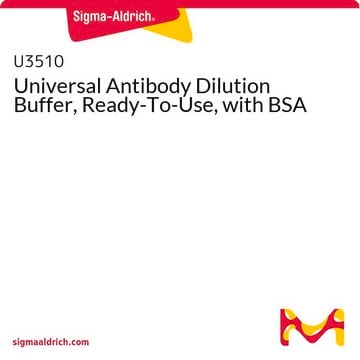Recommended Products
pH
7.3-7.5
application(s)
hematology
histology
storage temp.
room temp
General description
Ready to use buffer for dilution of antibodies in all immunoassays. This buffer does not contain any mammalian proteins, phosphate, sodium azide or mercury preservatives and can be used for dilution of all antibodies, including peroxidase conjugates and antibodies to phosphoproteins. Not suitable for dilution of antibodies to S100 proteins.
Application
For dilution of primary or secondary antibodies. The diluted antibodies can be stored at 2-8 °C for several weeks in this buffer.
Universal Antibody Dilution Buffer has been used in immunoblotting.
Signal Word
Warning
Hazard Statements
Precautionary Statements
Hazard Classifications
Aquatic Chronic 3 - Skin Sens. 1
Storage Class Code
12 - Non Combustible Liquids
WGK
WGK 2
Flash Point(F)
Not applicable
Flash Point(C)
Not applicable
Certificates of Analysis (COA)
Search for Certificates of Analysis (COA) by entering the products Lot/Batch Number. Lot and Batch Numbers can be found on a product’s label following the words ‘Lot’ or ‘Batch’.
Already Own This Product?
Find documentation for the products that you have recently purchased in the Document Library.
Customers Also Viewed
Caitlyn Fastenau et al.
GeroScience, 45(3), 1539-1555 (2023-03-04)
Terminal sialic acid residues are present on most glycoproteins and glycolipids, but levels of sialylation are known to change in the brain throughout the lifespan as well as during disease. Sialic acids are important for numerous cellular processes including cell
Caitlyn Fastenau et al.
Brain pathology (Zurich, Switzerland), 34(4), e13267-e13267 (2024-05-10)
Glycosylation is the most common form of post-translational modification in the brain. Aberrant glycosylation has been observed in cerebrospinal fluid and brain tissue of Alzheimer's disease (AD) cases, including dysregulation of terminal sialic acid (SA) modifications. While alterations in sialylation
Zhihui Li et al.
Cell biology international, 46(10), 1672-1681 (2022-07-14)
Bladder cancer (BC) is a common urological malignancy that still lacks an effective treatment. Doxorubicin (Dox) has been widely used in the treatment of various cancers, including BC. However, chemoresistance often hampers the clinical application of Dox, therefore, it is
High level of calpain1 promotes cancer cell invasion and migration in oral squamous cell carcinoma.
Ma D, et al.
Oncology Letters, 13(6), 4017-4026 (2017)
Da Ma et al.
Oncology letters, 13(6), 4017-4026 (2017-06-08)
Calpain1, termed conventional calpain and a member of the Ca2+-dependent neutral cysteine proteases, is considered to be involved in cancer formation and development. However, the effect of calpain1 on oral squamous cell carcinoma (OSCC) remains poorly understood. The aim of
Our team of scientists has experience in all areas of research including Life Science, Material Science, Chemical Synthesis, Chromatography, Analytical and many others.
Contact Technical Service










